Editor’s Note: This article was inspired by an idea left in a comment by Left Coast Chuck, one of our most respected readers and opinion leaders.
Cooking oil is one of the key elements in any prepper’s food supply. It’s a great source of energy and essential fatty acids, it adds flavor, and on top of that it just makes a lot of things easier to cook. If you’ve built up a serious food reserve, substantial enough to get you through a winter or the worst of the radiation danger after a nuclear attack, you probably have gallons of oil stored.
Oil stores fairly well, but it doesn’t last forever. Even in ideal storage conditions it’s going to start to deteriorate, and after a year or two you’ll probably notice a decrease in quality. The worst case scenario is part of your oil supply going rancid, which makes it pretty much unusable for cooking – and potentially dangerous if you do cook with it. Usually, rotating your stock will avoid that; older oil will get used up before it has a chance to get rancid.
Related: How to Prevent Your Foods from Going Rancid
Sometimes things go wrong, though. A damaged container that lets air in, some mishap that exposes oil to repeated temperature changes or sunlight – there are various ways you could find yourself with a few gallons of rancid oil on your hands. Hopefully, if that does happen, it will be before a crisis hits – that way you’ll have time to replace it with fresh oil. But, whenever it happens, you still have a load of rancid oil to deal with. What should you do with it?
Most people, of course, are just going to get rid of it. It’s cooking oil, after all, and if you can’t cook with it that makes it pretty much useless, right? Well no, it’s not that simple. Even rancid oil has uses that make it valuable in a survival situation. You’ll certainly want to replace it in your food reserves, but don’t pour it away – with a little bit of knowledge, it can still boost your chances of getting through in one piece. Here are a few things you can use it for.
Lamp oil
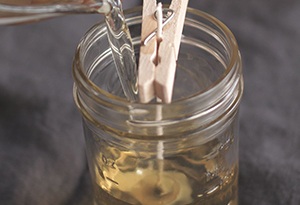 Oil lamps are one of the simplest ways to give yourself light and a bit of heat. At their most basic, all you need is a container and a wick.
Oil lamps are one of the simplest ways to give yourself light and a bit of heat. At their most basic, all you need is a container and a wick.
That makes them extremely easy to improvise, and if you have a handy source of fuel for them – a gallon of rancid vegetable oil, for example – why not?
Wood finish
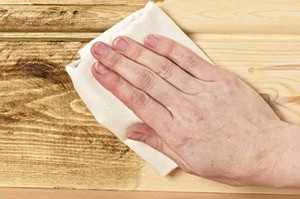 You’ve stockpiled some vinegar as well, right? Mix equal quantities of vinegar and rancid oil, and rub it into wood. It makes a great polish and conditioner; rub it in and buff it up, and you can restore old, scuffed wood to an amazingly good appearance. Use it on butcher blocks and wooden work surfaces, too – the oil gives a water-resistant finish that’s easy to wipe clean. Before using the mixture give the bottle a good shake to mix it up, because the oil and vinegar will separate out if you leave them standing any length of time.
You’ve stockpiled some vinegar as well, right? Mix equal quantities of vinegar and rancid oil, and rub it into wood. It makes a great polish and conditioner; rub it in and buff it up, and you can restore old, scuffed wood to an amazingly good appearance. Use it on butcher blocks and wooden work surfaces, too – the oil gives a water-resistant finish that’s easy to wipe clean. Before using the mixture give the bottle a good shake to mix it up, because the oil and vinegar will separate out if you leave them standing any length of time.
Basket preservative
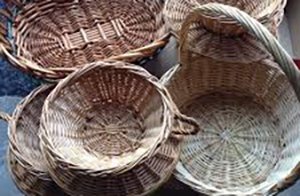 Wicker and rattan baskets are useful containers that, in a long-term survival situation, you can make yourself.
Wicker and rattan baskets are useful containers that, in a long-term survival situation, you can make yourself.
They do need some maintenance, though, or they tend to crack and split. Rub some warmed rancid oil into them to give a glossy, water- and dirt-resistant finish.
Lubricant
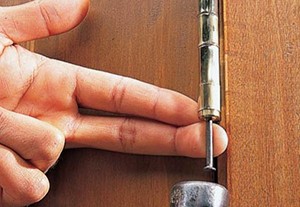 Cooking oil is no match for modern, high-performance lubricating oils – but then, how often do you actually need high performance? If all you want to do is quiet down a squeaky gate hinge then a few drops of rancid canola will do just fine. Keep specialist oils for jobs that need them, and use spoiled cooking oil on the rest.
Cooking oil is no match for modern, high-performance lubricating oils – but then, how often do you actually need high performance? If all you want to do is quiet down a squeaky gate hinge then a few drops of rancid canola will do just fine. Keep specialist oils for jobs that need them, and use spoiled cooking oil on the rest.
Rust preventative
 If you want your tools to last, they need to be cleaned and oiled after use. That will keep rust from attacking them. It’s a bit wasteful of oil, though. In a long-term crisis refined oils are going to become scarce, and do you really want to be using them to rustproof your shovel? Next time you use it the oil will all end up in the ground and you’ll have to use more once you’ve cleaned it. Slap on some rancid cooking oil instead; it’s just as effective. If you don’t have anything else you could even use it on your guns, although it’s likely to smoke when you fire. What would you rather have, though – a bit more smoke, or rust in the bore?
If you want your tools to last, they need to be cleaned and oiled after use. That will keep rust from attacking them. It’s a bit wasteful of oil, though. In a long-term crisis refined oils are going to become scarce, and do you really want to be using them to rustproof your shovel? Next time you use it the oil will all end up in the ground and you’ll have to use more once you’ve cleaned it. Slap on some rancid cooking oil instead; it’s just as effective. If you don’t have anything else you could even use it on your guns, although it’s likely to smoke when you fire. What would you rather have, though – a bit more smoke, or rust in the bore?
Related: 18 Vintage Homesteading Tools to Search for at Garage Sales
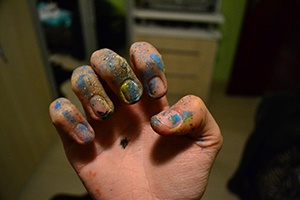
Paint remover
If you’ve got paint on your hands, don’t worry; cooking oil will help you get it off without painful scrubbing.
Massage some oil into the affected areas, then give it five minutes to sink in. It will loosen the paint so you can wash it off with soap and water.
Making soap
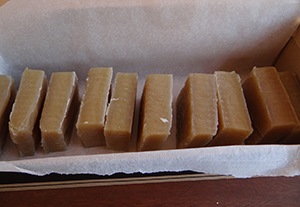 Oh, you’re out of soap? No problem; rancid oil is an ideal raw material for making your own. The other main ingredient is lye, and you can make that yourself from wood ash. There’s an art to making your own soap and if you’re using rancid oil you need to get it exactly right, otherwise you’ll end up with rancid-smelling soap. Luckily, rancid oil is a cheap resource to practice on.
Oh, you’re out of soap? No problem; rancid oil is an ideal raw material for making your own. The other main ingredient is lye, and you can make that yourself from wood ash. There’s an art to making your own soap and if you’re using rancid oil you need to get it exactly right, otherwise you’ll end up with rancid-smelling soap. Luckily, rancid oil is a cheap resource to practice on.
Related: DIY Wilderness Soap And Shampoo From This Plant
Biodiesel
If you have a diesel engine of any sort, it will happily burn as much rancid oil as you can get your hands on. Cooking oil is pretty much a one for one replacement for diesel fuel; engines will run on it without modification or any noticeable loss of performance. Just filter the oil first to remove any impurities or water. Many people are saving themselves a lot of money by collecting used fryer oil from local restaurants, filtering out any food residue, then using it as biodiesel. Rancid oil works just as well as used.
For many of these uses, you don’t have to wait for oil to go rancid. Got a fryer? You need to change the oil in that regularly, to prevent dangerous chemicals building up in it. Don’t pour away the old oil; it’s still fine for fuel, rust-proofing or lubricant.
You may also like:
33 Essential Foods to Stock Pile
7 Things You Should Do Immediately After an EMP (Video)
5 Ways to Make Survival Candles From Household Items
How To Stockpile Lard, The Calorie Rich Survival Food Of The Great Depression

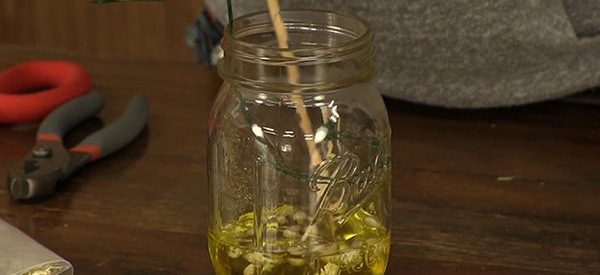




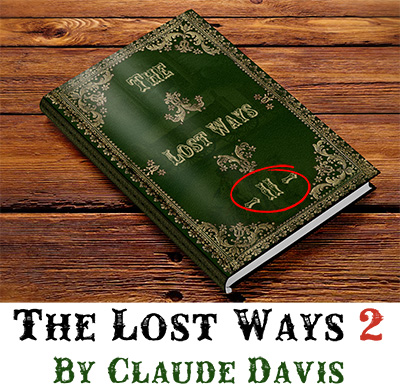
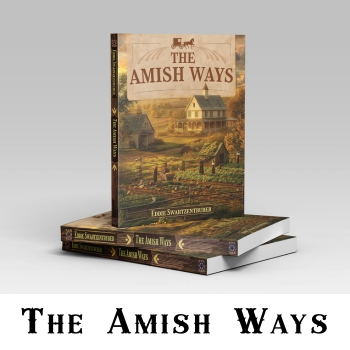

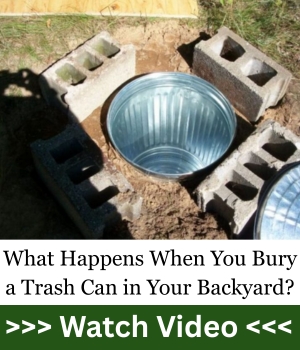






Excellent timing on this one. I found a gallon of peanut oil thats years out of date. Its still sealed up but I think i will try some of these ideas.
In an ETOW situation where food is scarce, I would use the smell and taste test before I consigned it to the lamp oil category. Smell the oil. Does it make you go “Aaagghh”? If it smells like peanut oil, proceed to step two. Wet the end of your finger with the oil and taste it. Do you go “Yuuuckkk”? If not, proceed to step three. Swallow a quarter teaspoon full or mix it with a little vinegar (balsamic or red wine if you have it or apple vinegar but worst case, straight old white vinegar) and put it on bread or some greens. Wait 24 hours. If you haven’t had a significant reaction, it is still good as a food item. It may have a very short shelf life after you open it, so you don’t want to stick it in the back of the pantry and forget about it for another couple of years.
In an EOTW situation, foodstuffs will become quite scarce and you won’t want to consign acceptable food to some non-food use if it still has value as a food item.
Today, because you can buy fresh peanut oil at any number of local markets, it isn’t necessary to go through the sniff, taste, try regime. It can go straight to the garage for use as a lubricant.
It will burn with a wick in a tuna can but it is smokey and best used out of doors. If there is nothing else to use, you can use it indoors, but don’t use it to illuminate the oil painting of your favorite relative. It will smoke it up.
The way I made a tuna fish can oil lamp is I cut cardboard in thin strips that would fit inside the can when coiled in a circle. I cut it so that it was about 1/8″ below the lip of the can. I put enough cut cardboard in the can so that the wick, when placed in the middle of the can would stand up and could be adjusted for height. I then filled the can to the top of the cardboard. It will take a while for the oil to soak into the wick, allow about an hour. The first time you light it it will probably take two or three matches to get it started. After the wick has charred a bit you can light it with just one match. To put it out I just turned another empty can upside down over the candle can.
Will Tiki torches work for this?
Same thing happened to me. I use it for charcoal lighter
Thanks
Good way to use up those non-saturated fats. They are high in Omega 6 which is not good. Want more omega 3’s
Besides heating most cooking oils turns them into trans-fats. NOT GOOD. Check it out.
Biodiesel is actually a chemically altered form of vegetable oil. What you described is “straight vegetable oil” or SVO.
Will it still run a diesel motor or does SVO need some kind of processing to enable it to be burned in a diesel motor?
If it needs some kind of processing, how about writing a piece as a response to this message about how to process it — that is if it can be described in less than 10,000 words.
If it can’t, I am sure Claude would welcome an article about how to process rancid vegetable oil into usable diesel fuel and I think the followers of this site would find it useful.
Bio-Diesel Formulas are all over the internet. The things to know about bio-diesel are:
1) When put into a diesel tank that has been using petro-diesel, there will be a cleaning out of the tank causing the fuel filter to need more cleaning or replacements.
2) All rubber parts may be eaten away because of the high alcohol content: Bio-Diesel is made using WVO, Lye and Methanol (However the methanol is primary used to aid the reaction process and if you have a methanol collector can be recovered as it is usually evaporated off.
3) You actually have to have a diesel engine to run it through so motorcycles and lawn equipment would not work with bio-diesel, but a diesel generator with rubber made to withstand the aggressive nature of methanol would work great.
LCC …. generally, SVO needs to be heated (and filtered well) to run a diesel. Of, course, the diesel engine was initially run on vegetable oil in the late 1800’s.
i would have like to had taken advantage of some group offerrs but i thought they were digital and not physical books and i like physical books.
Marlou — Me, too. I won’t read digital stuff. Only physical books. It’s irritating to me to find something that looks like a really good (or informative) read, then to find it’s ONLY in digital format. Many websites do this. I assume it’s to save them money? I don’t know, but I miss out on a lot of good information because I can’t/won’t read digital (gives me a head ache, among other things).
Print it out then read it.
Print them out on good, treated paper and they last decades longer than any printed book. Acids (from the wood and other plant materials) develop in paper and cause it to break down and get brittle.
you can get decent laser printers 50-60 bucks. come with 750 page toner and replacements 1500 pages
just price aftermarket toner i have Samsung about 7 yrs old cartridges are cheap on amazon inkjets would cost too much.i use my ink jet only for pictures or color
I don’t know what you mean by “treated paper.” If you mean coated stock, that doesn’t necessarily last any longer than uncoated stock. Coated stock is covered with a very thin layer of clay. The slick finish allows for sharper dots which makes for cleaner appearing color pictures. Also colors stand out more because they are not absorbed into the substrate, the paper.
If you are interested in archival paper, you need low acid paper. That can be either coated or uncoated. If you are using a laser printer, I would recommend uncoated archival paper. If you fuse the toner on coated stock, it doesn’t penetrate to the substrate and just fuses on top of the clay coating. Eventually it will flake off as it is flexed with handling, thus defeating the sought after archival longevity.
Actually today, the old acid treated paper has gone the way of buggy whips and carbon paper. Most paper today is not acid treated. If you buy a good quality 20 pound or better yet, 24 pound bond, It should last a significant period of time. You won’t see it turning brown in 20 or 30 years.
I would also recommend using a good quality toner if you want archival quality. It doesn’t do much good to buy good quality paper if you insist on putting el cheapo toner in your laser printer. Same with heat fused copiers. Use good quality toner in your copier if you want archival properties.
So how come I purport to know so much about paper? Well, in one of my lifetimes I owned a printing company for 25 years and as you might imagine, knowledge of paper was relatively important.
Chuck: I never heard of acid treated paper in the trade, or at least anything called acid treated. Paper is naturally acidic, and so is any oil used in the ink. If I wasn’t clear, apologies. When you hang with people who all do the same thing, you tend to use the language. This is basic librarian/publisher terms, something I learned over a lot of decades. Treated paper is treated with a base, usually when it’s being made. https://en.wikipedia.org/wiki/Acid-free_paper Print company? I can smell the ammonia even now 🙂 to treat regular paper, this is a good product. https://www.pfile.com/prod_detail_list/Archival-Mist-and-Paper-Bright-FAQ And, we learned to make paper like our grandparents did in the 19th century, as well as ink, paint, and so on. Just like I think you probably did. After being disabled, I went to writing, then editing because I had trouble doing a physical job. Pretty much everything interests me and I do not expect to survive a whole lot longer, I teach what I can and try to do it out of respect for all of you. niio
Red: In the sulfite process of making paper, an acid is used to reduce the pulp to the form necessary to for the Fourdrinier machine to produce the finished product. It was the acid content in the paper that made the paper turn brown and crispy. From about the mid 19th century to about the mid 20th century the biggest percentage of paper produced was produced with the sulfite process.
The kraft process which has become the predominant process for making paper doesn’t use an acid to reduct the pulp and thus kraft paper is longer lasting.
The Library of Congress is in a race against time trying to eliminate the acid content of tens of thousands of books printed during the time period on high acid paper. Books are literally crumbling on their shelves because of the paper process. It was a two edged sword. It was a cheap way to make paper which made books, periodicals and newspapers available to many more people. But, alas, some great literary works were printed on high acid paper and are crumbling to brown shards on library shelves.
When we started our printing business in the early 70s, most colleges required doctoral theses to be printed on 24# archival bond which was low acid 100% cotton fiber bond paper. It made printing a PhD thesis quite expensive. Fortunately, by the mid 80s most colleges had dropped that silly requirement. Money is printed on 100% cotton bond paper in the U.S. Some foreign countries have gone to printing their currency on polyester which has an even longer life than 100% cotton paper.
I could go into the history of paper making in the U. S. and the importation of mummy wrappings from Egypt in the 18th century which wiped out the paper industry in New England from the anthrax spores in the wrappings but that is a lecture for another time.
Red: I reviewed both of the references that you listed. Wikipedia is saying basically what I tried to say. They go into much greater detail than I attempted. If anyone is interested in the history of paper making the Wikipedia reference is a good start. In an EOTW situation, we will once again be back to making paper by hand with screens and felts in a frame.
The archival reference describes one of the chemicals used to treat high acid paper to preserve it from deterioration. The daughter of a professional colleague of mine is an archivist who works in preserving books, a somewhat esoteric specialty occupation but with lots of job opportunities with all the book collections with hundred year old books falling into crumbly little pieces of brown paper.
If libraries when I was in middle school could send out books to be treated, why are they taking so long? the librarian at school told me, she got a donation for this, so the school couldn’t confiscate it. Any older books were sent out immediately. The rest went out after school let out for summer.
Yeah, I met some of those folks who specialize in restoring ancient documents. You have to love to be a loner to sit there, piecing crumbled pages together hours each day. Odd thing, we had the original deed for the farm. by law, in the 18th century, they had to be on velum. It had sat in a trunk in the house attic for a couple of centuries, and was still in good shape. the edges had browned and cracked, but you could handle it with no problems. You’d think after washing, stretching, tanning, and bleaching it would have made it more delicate, but the bleach used is a basic. BTW, dioxin when used to bleach paper causes it to deteriorate. It can’t keep away book beetles for more than tn years, either, a librarian in Brooklyn told me. But, the kids grew up learning how-to the old way, every way, just as I did. niio
Our company had an assignment to reproduce a diary from the very early 19th century, 1810 or thereabouts. It was a beautiful book, still in very good shape. Because the paper in the diary was 100% cotton paper, it was in much better shape than some early volumes in my library which, unfortunately, are turning brown because they were printed on high acid paper.
The handwriting also was a thing of beauty. Although the diary started when the lady was quite young, at that time penmanship was highly esteemed by educated folk. I am old enough to remember that the school used to award prizes for penmanship. Sadly, I never put the effort into it that I wish now I had. I suppose I could learn penmanship at this late date, but I spent 30 years pounding on keyboards and am really oriented in that direction.
The most beautiful handwriting I’ve even seen was a man’s. Moms was beautiful but his was ornate yet entirely readable. As hard as I tried mine and dad’s looked like chicken scratches
My handwriting is so bad, the doctor can’t read it. My mother gave up trying to get me to use copperplate, but my sisters learned it. It is nice, English calligraphy, and should be taught. Donno how many people I hear from who are angry that their state doesn’t even teach cursive or small letters any more.
I used to collect old books. I liked them because they were old, and took good are of them. some were from the late 18th century, but, then, anything like that was on cotton or linen. Even onionskin paper will keep better than the cheap crap they use today. If you can, try to neutralize the acid in something newer that isn’t needed. Expose it in your attic for a year. Untreated high-acid will brown, but if it works, the paper should look like new
Old journals are cool. they give insights to what life was like then. Reminds me of a teenager’s journal from the late 19th century. Her father got a job as mine manager in Bodie, CA. The town had a bad rep, and the girl wrote, “Good-bye, God, I’m going to Bodie.” Somehow, just reading how bad the town was in history books just ain’t the same thing. niio
Hi Marlou,
Thank you so much for your interest in my work.
At the moment there are 3 books available both in digital and physical copy. These are: The Lost Ways, The Lost Ways II and The Lost Book of Remedies.
God bless,
Claude
Just like Dinie, I found a gallon of long expired canola oil the other day and I was thinking of pouring it out. Now, I think I’ll hang onto it.
Thanks for the timely article.
There are floating candle wicks available cheaply on line. I use these in a squat glass with 90% water and 1/2 inch of oil. Plenty of oil for hours of light. If it accidently gets knocked over the water stops any fire hazard.
Floating candles look pretty and are really simple.
If you have oil that you have cooked food in, I would not use it on my guns. Even if you strain it, there may be dissolved salts in the oil that would not be helpful on your custom fitted Franchi over and under shotgun. Fine for preserving tools that are going to dig in the dirt or lubing something that just needs a little slicking up to make it work better or with less noise. Also quite good for using as a fire starter or as an oil lamp. You really don’t care if your tuna fish can oil lamps have some residue in the bottom. It might even be okay for preserving wood that is going to be outside. I recently read that wood that had been sprayed with salt water over the course of years became as hard as a rock with the impregnated salt.
You can make a torch to use in place of a flashlight — you know, all those zombie movies where the zombies are running around with torches? Or the natives storming the castle with torches? If you fuzz up the piece of wood and soak it in rancid sunflower oil it won’t be as bright as your 2,000 lumen Fenix, but it will be a portable light that has served mankind for tens of thousands of years.
Biodiesel is often used oil from restaurants, especially Chinese restaurants. I think it would be fine to use in a heating oil stove.
Would boiling it with water take out salts? It helps to get rid of dirt in the oil.
Red: I don’t know but I would be very leery about boiling oil with water. I’ve never tried mixing oil and water and then boiling it. I would think splattering would be a real hazard. They both boil at vastly different temperatures.
Have you actually done this? Did you continue heating past 212 °F to the boiling temperature of the oil? Did you encounter splattering of the water boiling at a higher temperature than 212? How much did you boil at one time? Hot flying liquids give me the willies.
What you say is valid, if you let the water run out. If this is so deadly, why is it considered a science project for 9th grade students? Amish are doing it. You describe a worse case scenario using high-tech, not things available on the farm.
Yes, I have boiled water and oil together. Every time I make deer steaks or cheap cuts of beef. Add water and shorting, medium flame, cook the water out. Fry steaks, which come out nice and tender.When cleaning cooking oil, add water to pot of grease, raise heat on a medium flame, grease melts and does not spatter unless, again, you run out of water. I have had hushpuppies explode, but I still make them.
https://www.motherearthnews.com/green-transportation/biodiesel/home-biodiesel-production-zm0z15aszmar
Making biodiesel is encouraged by Star, Dept. of Energy for home use, and tested by them and regular, non-science farmers and homeowners making it. The alcohol used as a drying agent is more deadly. Biodiesel is washed using a pump and an old water heater, and about 1/3 water, not cooked out. Cooking as you described is done by refineries, not at home. Home-washing takes out impurities, dirt and other things that would burn out an engine fast. It’s been done since long before either of us were born, young man! 🙂 Water and oil are allowed to settle out for several days and the water removed via the lower pipe. the rest is filtered and used. Waste water is filtered but, it’s no longer water, but is now glycerin. If that bothers you, do not mix with nitric acid.
Well, I answered my own question. I went to the website posted by Red: “makebiodiesel.org and read the following:
“Boiling the water out is the most energy-intensive method of drying oil, and it heats the oil to dangerously high temperatures.
warningBoiling the water out of the oil is also the most dangerous way to dry oil. If you are not actively and vigorously mixing, water settles to the bottom while you are heating. The oil above the water pressurizes it, elevating the boiling point of the water. If the oil is jarred or bumped, it can release the pressure on the water enough for the water to turn instantly to steam. When it does, it expands rapidly, throwing boiling oil out of the top of the container. Think of a cannon shooting boiling oil. It is that powerful. Oil can be thrown up to 20 feet away, seriously injuring anyone in the path of the boiling oil. So… boiling the oil is not the way to go unless you are constantly stirring while heating.”
That sounds a little more exciting than I would want to try just to use some old cooking oil on my guns. I can just visualize globs of hot oil flying through the air like some medieval catapult hurling buckets of hot oil at invaders.
Might make a great defensive weapon, get a large trough, put water in it and add oil, put a fire under it and some means of jostling the trough when the zombie hordes are advancing, globs of hot oil hurtling through the air would be disconcerting at a minimum.
Red asked about boiling to remove salts. The article dealing with biodiesel had a paragraph about salts in the oil that I didn’t bother to read. The globs of hot oil as far as twenty feet cooled my interest in further reading.
I think in an end of the world situation, vegetable oil will become a very important product for uses other than food. It may be quite a while before we can get the oilfields producing petroleum for petroleum based products, but growing a huge field of sunflowers for sunflower oil takes only seeds, rain, planting and harvesting. Yeah, easy to say when I am sitting here at the keyboard, but the technical aspects are far simpler than getting oil out of a whipstocked well that is 15,000 feet deep. And then, of course, there is the little matter of turning the crude into a useable product which involves technical skills far beyond crushing sunflower seeds to extract the oil and then straining it to remove the unwanted portion.
I would like to see some articles on how to extract oils from a variety of foodstuffs: sunflower seeds, olives (ripe or green?) peanuts, walnuts, and other kind of common nut. Can one get oil from acorns? Are there trees that grow in North America that one can extract oil from and how to go about it?
Just some ideas that I would find very interesting. I know I could probably find the information if I spent hours on end on line, but a simple synopsis from someone knowledgeable would save all of us from trying to re-invent the round wheel.
SHFT hits, how will you extract oil from oilseeds? I was raised by people who did not like a lot of electric in the house or barns. Chia is still simmered with water, but that takes 24 hours of constant monitoring. Home-based oil extractors run on electricity. Yes, I know people who have them. Best tree to get oil from is the olive, but even that takes a lot more work than just drying worn animal fats. Best non-extractor method (stone wheel and an ox), 25% of oil is extracted. And, the veg oil goes rancid a lot faster than animal fats. When used in cooking,it evaporates faster, as well, and extracts hydrogen from the air, when makes it toxic after a while. After olives and chia, safflower seeds. But, for any interested in how-to cold estraction, https://www.survival-manual.com/oil-press.php
red,
What about rendering animal fats?
Bears, pigs, and groundhogs have some good fat to use if no more cooking oil.
Bull’s eye! Animal fats stay fresher longer without special storage vegetable fats do. the original biodiesel was made from animal fats, which then were more easily found than vegetable fats. And, after SHtF, will again be. Animal fats have a lower polluting factor, less nitrous oxide and so on. After cooling, they’re considered stable (grease and fat from prey has been found on weapons and tools in the Middle East was was still recognizable as animal fats (BAR review), vegetable oil goes rancid in 6 months or so).
http://biodieselmagazine.com/articles/3241/animal-fat-based-biodiesel-explore-its-untapped-potential
Yet animal fats were the original fat in early studies going back to at least 1841.
https://pubs.rsc.org/en/content/articlelanding/2012/gc/c2gc35219b#!divAbstract
Beef tallow is considered the best, I think, with fowl and fish the lowest. Beef tallow is most stable, followed by lard. It has a lower flammability rate (not much!) than the rest. But, it makes better candles than anything but wax.
The waste product it still glycerin. It can be used for soaps and a lot more. Do not add nitric acid to it…or take the ingredients to the mother-in-law’s for help while you and the better half take a long weekend.
https://en.wikipedia.org/wiki/Nitroglycerin
If you have access to the equipment they had when it was invented, 1841, it can be made–at the mother-in-law’s 😉
Sorry for not answering sooner, but there’s a time lag between getting a post and finding it at the site. niio
Also possum sometimes has a lot of fat. I don’t know how it renders out as I have never tried to render possum fat. In an EOTW situation, if one can render out possum fat, here in my neighborhood we will be in fat city (Sorry, pun fully intended) as we have oodles of possum who like to forage for pet food and are attracted to the dumpsters that the fast food places have. Also lots of seagulls and pigeons. I think I would really really have to be hungry to eat urban possum, pigeons and seagulls.
LCC.
The one possum I roasted in my oven was terribly greasy. You may indeed be living in fat city. 🙂
I don’t trust anything that eat rotting meat. I have had possum and it’s good, but not something I would want. Pigeons are usually pretty picky about what they eat. Seagulls? Probably taste worse than pork from the pigs a neighbor used to fatten every spring on carp.He would sell them at auction because no one local would buy one from him.
A few years aback, still stuck in the swamps of Penna., I lived in an interesting ‘hood. Lower middle-class with intentions toward poverty. When the dems screwed the economy, by the end of winter, no stray dogs or cats, and no tracks of rats in the snow. If you had a dove cote, the birds were kept inside most of the day. I was working in a coal mine, security guard, and got plenty of rabbit and a few deer to share with the neighbors. I took all the ground hogs I could, as well. Bubba the dachshund loves to hunt 🙂 After the neighbors ate a few, no more ground hogs in town, either. niio
Be careful of using old veggie oil as a wood preservative on your wood handled garden tools, shovels, hoes, axes, wheel barrow handles, etc. That becomes a very tasty snack for racoons, porcupines, rats, mice and other chewing vermin you might have on your homestead and yes, even bears. I know it happened to me. I’m not saying not to, just be advised, especially if you have an open tool or wood shed.
Hemp seed oil and flax oil (linseed) are drying oils; meaning, when applied in thin layers and heated, they dry to a hard, waterproof finish. This is the “seasoning” on cast iron pans. You can use rancid hemp or flax oil to protect the wood handles of your tools that way, by applying very thin coats and heating at a low to medium temperature until it stops smoking. I don’t think critters will be attracted to the oils after they’re heat-dried, because the smell would be more like smoke and less like food.
I like that even better than my tuna fish can lamp. Thanks for the info.
I don’t know about the other varmints mentioned in Rob’s post, but I know porcupines absolutely love anything with salt on it, gloves, boots, axe handles, shovel handles — anything that you handled with sweaty hands or feet they will chomp on given even a scintilla of a chance. That’s why you never leave your muddy boots outside your cabin in porcupine country. In the morning they will not be fit for a Goodwill donation. Nor do you leave your axe stuck in the stump you were using to split logs. In the morning at least half the handle will be gone.
I add turpentine. Still, used motor oil, when filtered thru a cotton ball-filled hose is better and penetrates a lot better. A mechanic I know reuses his motor oil after filtering it. But, doesn’t recommend it unless you are a mechanic or in dire straights. All wood here gets coated with several times a year because the sun dries wood out fast (south-central Arizona). Veggie oil attracts termites, as well, unless treated with turpentine or something that tastes bad to them. niio
As long as I got blamed for this particular subject by Claude, I will mention something else that I don’t do that all the prepper manuals recommend. I never throw out a battery until it is dead and leaking acid. Many prepper manuals recommend throwing away batteries that are passed their use by date. I have a cheap battery tester I think it cost less than $10 years ago and while I haven’t checked, I feel confident that Amazon sells a selection for less than $20.
Before I ditch a battery, I check it to see if it will move the needle. If it does, I don’t chuck it. I keep it. It will make a light shine a little bit and in an end of the world darkness, just a little light will be a help and even if it only lasts a day or two before it finally gives up the ghost, that is a day or two of light at night that I wouldn’t have if I tossed it with some life left in it.
In addition, batteries are heavy. AA and AAA batteries make ideal slingshot ammunition, so if they aren’t leaking acid all over, I wrap them in those pillow-pack air bags that you get with some shipments from Amazon so that if they do leak they won’t leak on things I don’t want ruined. I save them. I may need sling shot ammo and as long as I have the space, it doesn’t cost anything to wrap them in pillow pack plastic and put them in an Amazon box and in the storage shed. An 8″ x 6″ x12″ box will hold several hundred AA or AAA batteries and C and C sizes make even better missiles.
Before I toss anything, I try to think of alternative uses for the item. If saving it doesn’t cost anything and it doesn’t take up too much space and I have some reasonable alternative uses for the item I will save it. So the test is: The use has to be simple, not some off-the-wall use. The cost of preserving and storage has to be very low and not much work. As I see it, chucking a C cell battery at a bird or rabbit is about as low tech and simple a use as I can think of and with its weight, it should make a fairly good projectile if I do my part — or find some young guy who always wanted to pitch in the major leagues.
For those of you who can’t see the humor in my initial comment, it was supposed to be funny — that Claude blamed me for this the article.
LCC I have a solar battery charger for AA AAA C and D batteries And small flat round batteries. It was around $25 but its recharged a lot of regular batteries. I just load it up with nearly dead batteries and let the sun help work it’s magic.
In a saver, reused, repurposed…. My daughter says I can “pinch a penny till it screams quarter.”
I think old batteries might be good ammo for my “wrist rocket”. Have to try that out..
LCC if you’re guilty of inspiring this wonderful dialogue.. Good or you. 🙂
My parents heated a rural home with oil. It took a simple drip system to a burn chamber that looked like a tuna can. They lit the oil in the “tun can” and set the oil on a slow drip. It was quite warm. They bought it delivered in 55 gallon drums. I’d bet some handy guys could figure out a way to make a heater that could run on old or used oil. It burned in a stove that looked about like a wood stove. It was vented like a woodstove would be.
When I was in Tent Camp 2 at Camp Joseph H. Pendleton serving with Uncle Sam’s Misguided Children back in the mid 50’s during the winter months we heated our tent with a tent stove that sounds like what your parents used. We would go to the fuel truck with a 5-gallon can and fill it with kerosene. It went on a wooden holding arrangement at the back of the tent and the rubber hose to the stove went under the edge of the tent. kerosene dripped out of the hose into the stove and burned all night. In the morning, smoke from all the stoves hung in the air over Tent Camp 2.
The stove was a bear to get going, usually needing several sheets of newsprint before the kerosene would reliably stay lit. It did keep the tent cozy at night up in the hills behind Onofre. We filled the can every night because we couldn’t get two nights out of five gallons of kerosene and we most definitely didn’t want to have the stove go out overnight. It might have been sunny SoCal, but up in those hills it got down to freezing frequently. It wasn’t unusual to see frost on the dumpsters around camp in the early morning.
We used a somewhat similar device to heat water in galvanized garbage cans to wash our mess gear when we were out in the field and on Okinawa when the electricity was out due to a typhoon. the heating ring sat in the garbage can and heated the water with kerosene dripping out of the ubiquitous 5-gallon jerry can.
Back in those days of long ago orange orchards used smudge pots to keep the fruit from freezing. If you are really old, you might remember that road work was marked at night with smudge pots. They were round black metal bottles with a large wick and they were lit at night to mark areas where road work was in process. And, of course, all those devices emitted volumes of black sooty smoke.
All of those devices are now anathema here in the PDRK with voluminous air quality regulations.
You had an adventure-filled you. Yes, I remember the roadside smudge pots. Doing homework by an Aladdin lamp, going to the miller’s with loads of corn for cornmeal, oats and so on to be ground, then Mom calling family in town to share it all. Helping an old Great-Uncle clean his still,and how to work it without getting killed. Helping unload it when we made deliveries. Escaping the cops in Mexico who wanted to arrest me for working down there. Men and horses killed by cattle and in fights. It’s life and the enemy is out there, eager to destroy us. To enslave us. the enemy is and always has been the DNC. Welcome to the world of the redskin.
The home heater really was a lightweight oil. Not kerosene. The smoke went up the flue pipe. It took a wick to light it much like kerosene.
I like boiled linseed oil on garden tool wood handles and for my oil painting. I even use it on cutting boards but keep it warm while working and very thin then wipe off.
Is linseed oil actually flax seed oil?
I have beautiful wild flax blooming in my yard right now. Pretty bright blue 1/2″ flowers. Linen was made from the long fibers in the stems. I just let that patch grow a bit larger each year.
Dad used flax seed in the corner of his eye to produce a mucus to gather sandy dust out of his eye. Its also healing while doIng that.
Flax is edible as seeds or ground and added to breads.
I would not use boiled linseed oil on anything that touches food. Check the Material Safety Data Sheet (MSDS) on line. Try: http://www.kleanstrip.com/uploads/documents/KS_Boiled_Linseed_Oil_MSDS.pdf … Linseed oil derives from flaxseed oil, but food grade flaxseed is a different beast. I use that to season cast iron cookware and it polymerizes nicely when heated to the smoke point. Flaxseed oil goes rancid readily so is probably not the best for cutting boards. Try a good grade of mineral oil for that task.
Linseed/linen seed. Read what Farmer wrote. I never liked linseed for handles and other woods because it won’t penetrate deeply and can go rancid. It also dries too fast to use for cleaning old clocks and can get sticky. Half of the windup and grandfather clocks I cleaned had been cleaned with that. Mineral oil won’t dry fast or go rancid. It penetrates deep into wood. When I got the family kraut cutter off my sister, I had to wet it with the oil. It was green with mold, and the blades rusty. One coating, let it sit for a week, then washed it off with hot soapy water. the blades are black, but thing was made in the 1800s and still beautiful. Even the steel bolts had come clean. I took it apart on the kitchen counter and about got a heria when I lifted the board (4 feet by 12 inches, two inches thick). And almost put it thru the ceiling. It was light, American chestnut. When Mom had it, we used to make kraut by the barrel to bootleg in half-a-dozen towns.
Went hunting and found this from Native Seed
Blue Flax – Native
NSC042
Linum lewisii
This variety is native to the western U.S. (including Arizona), and is named for Meriwether Lewis, who documented it on his travels through the west. It blooms sky blue with 5 petals from April – September.
Blue flax is drought resistant and tolerant of alkaline soils. It needs well drained soil and prefers full sun. It is useful in erosion control.
The seeds should not be eaten raw, but are tasty and edible when cooked.
Used for fiber. Plant fall to spring.
I should buy some. If the seeds are even mildly toxic, the ants might leave something for me 🙂 Right now I’m checking kohlrabi seed heads and killing small ants opening the pods and eating the seeds.
The kraut cutter sounds interesting. I used to help my folks make kraut every fall. Moms favorite was to serve it was with apples, sliced then, cooked with the kraut as it heated. It was ok for a change but I liked kraut hot or cold. Grandma added caraway seed to warming kraut. It was how her pennsylvania Dutch grandmother served it. That was good if served with a good smoky sausage or bratwurst and homemade rye bread.
Our neighbor uses old motor oil on his tools. Oil is strained through a coffee filter setup into a 55 gal drum. He dips tools into the oil and lays them on an expanded metal sheet about 4’x4′. They drain overnight then he wipes them with a rag to put away. Done roughly once a year … Sometime two years. Tools from new to things from a grandfather all look nearly new.
Most of my tools are newer due to thefts so I hadn’t thought about oil. I do have a few hand tools and all of my dad and grandfathers planes. I need to resharpen a few. I have sanders but there is little that matches working with a good plane. They are. quick, efficient, and take no power source. Handy for a quick job. A bit of oil might be beneficial on them. I always used three in one oil on metal parts where I work. That includes my old sewing machines that need dusting inside the case and oiling now and then. I often repair old machines. Mostly they just need good maintainance and lubricating like any other machine. Without that they start freezing up and can’t move. I get a lot in that shape. Fix them up and give them away with a few sewing lessons if someone’s interested.
Well. Rain has moved to the east of us. Sun is shinning today. Supposed to be 85 this afternoon. I have trees to plant and a flat tire from the truck to drop off at a neighborhood garage.
I’ll need my truck Sunday. Picking up a bunch of 2×6 cutoffs 3-4ft long. I’ll use them in building a porch. I’m using old rickety trailer steps and that needs to change. Friends want to build it for me. I’m helping gather up materials. Anything extra will go into my root cellar project on the end of the walapini ( pit greenhouse). Then I need to figure out why the tractor won’t start since a neighbor used it…
Apples and ‘kraut are a natural. Because I don’t add salt, I can make ‘kraut and ham. Never cared for it with smoked sausage, but franks are good. We used to layers fermented ‘kraut (made with salt) and layers of beef and venison to store the raw meat. After three days, it’s sauerbratten. Some went to the smokehouse to be pastrami. to me, pickled beef tastes like pork.
I soak the handles, sometimes for months. Even when left out in the sun for days,the handles look good. I’ve done that to tools abandoned in the weather, even with cracks in it and it works.
Metal needs a little oil. We used to have sharpening wheels of all sizes we got at farm sales. People would buy them as decorations. We used them. More than one had to be unglazed from oil poured on it ’cause the user didn’t know they’re water stones.
I’d like to take the roof off the living room and replace it with greenhouse panels.Reflective types aren’t cheap, but worth it. They act like insulation, keeping the heat out but light in.Then, do like U of NM recommended in their tire houses, run the gray water under planters. I’ve seen it work. Under the beds in the house and out to the water storage.
If I convert the tool shed to a greenhouse, what am I gonna do with ol’ Mouser? Does not play well with others, as a neighbor found out last fall. He doesn’t listen to music but sure loves to play that rattle attached to his tail 🙂
One thing he does well, he scared off a peeping tom a few nights ago. It’s a woman from up the road. No lights out back, and it was pitch black when she was looking in the windows. I hope she didn’t scare Mouser too bad when she screamed and knocked over the tools under the eves. Poor Mouser, huh?
http://www.make-biodiesel.org/Introduction
Mind the chemicals. Use rubber gloves because there are chems that if only a drop or two on the skin can cause health problems. Mother Earth News and Countryside small stock journal (that one’s written by preppers interested in homesteading) both had articles on it. CJ has plenty of free guides. This is their facebook page, if you want to check them out. https://www.facebook.com/IAmCountryside/ Online subscriptions are free. Bio-diesel is in the archives. niio
I like the post. But, dry onion skins, cut into small pieces. soak, bring to simmer, remove to a flat surface, place fly screen over them, roll out, press and dry. Non-acid. Adding a little baking soda helps, as well. We did this at home to stay busy during in bad weather. Dad even used the hammer mill (stock feed) to make wood dust fine enough to make pulp for paper. Dad tried, it cam out like rough toilet paper, so, dampen it, use two fly screens and put it thru the wringers on the washing machine. the thing is, most acids go with the water used to soak the material. The rest is neutralized by adding a little backing soda. Sludge on the bottom went to the manure heap because it had tough fibers. niio
My wild blue flax is in bloom right now. Plants are 18″-24″ tall with the flowers on growing tips. Tall slender plants. My great grandmother in rural NY state used to grow flax and process it to get the fibers. She then spun it and wove it into cloth and sold a lot of it to help support her large family. It was a coarser product than modern commercial linen. Still it would have made nice tablecloths or bed covers. Mom said the relatives all had linen for window curtains when they wanted it.
Ya talked me into it. I ordered wild flax from Hudson. I was looking over their catalog and could have slapped myself. He carries Safflower, as well. That gets planted in late winter and had an oily seed in it. It’s perfect for a hidden garden. A woman stopped to talk and asked what those pretty flowers were. I looked. No flowers. “Oh, those white ones!” Those are onions. “Oh, yeah, flowering onions. those are nice.” And the brother-in-law of a friend who wants to cut down an apple tree because the fruit is so messy. His neighbor was thinking of cutting down a few Canyon palms because fruit was messy. A neighbor who loves her grapefruit–for the flowers. Every summer he son has to rake them up and they throw them away. I’ll take them! There’s civilized and over-civilized. I think I’ll stay a barbarian. niio
If civilized folks trash fruit I’ll agree…. Call me barbarian. I grew up helping my folks glean harvested orchards. Sometimes free and sometimes cheaper. We canned or dried it.
Mouser… I almost stepped on one yesterday. I was carrying buckets of water for the newly planted elderberries. A broad dark head caught my eye. I was about to step right behind that head. Quick freeze! Slow reverse a few steps then I stood to watch him. Laying there flattened out sunning himself and never flinched. Look like a calm nap. Finally walked on to turn off the water I had running on the rhubarb and a walk back to check on the mouser. No where insight.
Hope you enjoy the flax as much as I do. A neighbor shared that he mashes the seeds. Covers them in well water and boils 15 minutes. While still quite warm he stirs and spoons off the oil floating on the water. Then slowly simmers till the water evaporates and just leaves the oil. He uses it for his artwork. I may have to try that.
I love old books. Still have some.
Y’all got to watch out for ol’ Mouser. He’s the sensitive sort. Even emotional of times. DOES NOT PLAY WELL WITH OTHERS. Mouser’s attitude is understandable, after all, Eagle is always eager to make the acquaintance of the Mother of Death, Mouser.
Flax, works with chia, but the oil is lighter. Now, if you can, an old pressure cooker, chia, water, slow heat. The pipe coming from the cooker should be copper. Just follow directions for cooking a batch of the old, traditional product.WARNING: If anyone does make that in a pressure canner, acid will eat away the metal and poison you! This is to distill oils.Foots, the remains, are dried and ground for flour, but chickens go gaga over it, too. The chia is up but waiting for the rains.
God bless and be healed!
I think mouser must have been so into his sunbathing I didn’t even register on his radar. Years ago I beheaded a mouser the hard way. Held him with a long forked stick I was using for a walking stick while I used a neighbor kids dull, short, pocket knife. Defiantly not a comfortable moment. Skin did look nice as my father in laws hat band.
I don’t kill every dirty, belly crawling, mouser. Just the ones with pointy ends. If I’d have had something more useful than an empty rubber bucket in my hand I’d have rid my yard of that unwelcome guest.
Prairie mousers are short tempered but the most aggressive by far that we see are Mojave mixed with praire. I didn’t know they did that.
Speaking of unwanted guests, I heard my first mosquito this evening. I have remedies that are gentle and natural for this kind of guest. Tomorrow the mint pot moves in. That’s a start.
Well working a bit at a time I’ve gotten 1 mulberry, 2 apple, 2 pear, 2 peach 3 cherry and a mulberry tree planted. Tomorrow after a funeral for an old friend I’ll plant 2 plums, 15 raspberries, 25 strawberries, 3 blackberries, 4 grapes and 3 roses…. Or at least what I can of that list. Then Wednesday we have Dr appointments an hour from here. I’ll try to finish up any remaining permenant plantings and work on watering.
Then comes the fun part. I’m finally going to plant the garden nearly 8 weeks later than normal.
Grandmas 45 day tomatoes will be ready starting to pick tomatoes in 6 weeks after transplanting. Ii have more cucumbers, melons, and squash about ready to set out. Normally I be harvesting some things by now.
Its a really strange year. Glad I had extra seeds to restart most things. I didn’t even try to restart pumpkins or long term melons.
At least it looks like we will have some garden. Too many places won’t be planting this year.
Ah, well, bad news is, they always know you’re there. They feel vibrations. Donno is it’s true, but herpetologists say rattlers can feel mice running away from them. In snake country, if you want to, carry a stick with long feathers on the end. Birds big enough to have large feathers are frightening to snakes. that’s why the snake handler’s partner in the rain dance carries an eagle feather.
I’m never without a knife. Just in case. But, neither has any struck at me. I’m not bragging. I can tell when one is close. My calves start to get ‘nervous’. I walked by copperheads, even stepped on them and they just crawled away. Same with bees. My stepfather would get angry about something (PTSDs from Korea), and start to argue with me. If a bee were near, it would sting him. My parents, BTW, were terrified of snakes. I don’t like them but they serve a purpose. God doesn’t make mistakes. Blame the devil for the poisons. It’s only that the ground squirrels are coming in that she’s back. And, when they had all those deaths fro the hanta virus in the Big Rez, it was blamed on that people killed off the rattlers living near town.
No ‘skiters here, yet. But, the water is in the pool, waiting for them, and the birds lining up on the back fence. I’m starting to see more bats in town, as well. When the monsoons start, there’ll be plenty of dragonflies to eat them and the rest of the bugs.
I’ve been working in aggie for decades. We get one ‘normal’ year out of ten. All the rest are strange in their own way. For every setback, there’s ten advantages if you know what to look for. My garden is ‘way late, too, but if the frosts hold off, there’ll be a ton of tomatoes from the Porters, chilis, and sweet potatoes. The pear came yesterday and I had to stick it in a bucket of dirt till after the operation. It has leaves on it, but they’re yellowed. Hopefully, they’ll green up, not die. The goji is out front under the eves and still blooming. Cute, but the thorns aren’t so cute. Still, it’s Arizona. If it ain’t got horns, thorns, or fangs, it’s poison!
The melons are all up and starting to run. No fruit, not in this heat, but it’ll happen. Everything grows slowly now, until the rains start. The best irrigation around can’t beat one thunderstorm for making the crops thrive. Yeah, I’m replanting a lot of seeds. Only a half-dozen of the sanditas (cucamelon/mouse melon) survived the cold snap. The one that survived winter was doing well. They’re supposed to be a perennial here. The turnip gone to seed is bigger than the plum tree I put out this spring. Like, it takes all the water, so that has to be cared for tonight. No figs, but the cold nailed them. The tree should bear a second crop soon. Safflower, wild tobacco, and what is growing are all doing well.
And, with everything else, Bubba has ear mites, again. They come out and bite the heck out of me at night. So he got doctored with Vicks in each ear. Mites hate the smell and it suffocated the rest. I use it, too.
Yeah, I love that 90 minute drive to the VA. But, that’s the price we pay to a little freedom.
Peace to you both. niio
Left Coast Chuck: THANK YOU for this awesome article about using up rancid oils! What a help you are to all of us out here, the readers of Ask a Prepper! I have some old olive oil in a unopened can that I was thinking about saving for oil lamps, as I am allergic to some of the oil lamp “oils” that are sold in Walmart and other such places. THANK YOU for letting me know that I am on the right track! We live not far from a settlement or two of Amish folks, so I’ve already purchased some oil lamps and extra wicks, but was unsure about which oils were safe to burn and which not. Thanks again! You are much appreciated!!
By the way, we do buy a number of things from their “local” Amish store! They have wonderfully useful non-electric items, fantastic cookware, etc. all at reasonable prices! As a matter of fact, last year when there were zero canning jars, lids, and rings to be found anywhere, we went to the Amish Store and they still had plenty!!
Oh, and I forgot to mention that the Amish Stores generally carry these awesome extremely large tea kettles for heating water for your bath, too. I figure if we lose electricity, at least we can use a wood fire outside or an old propane grill, which my husband adapted/coverted to be an outdoor canner. Anyway, I’m pretty sure we could use that LARGE kettle for creating warm or hot water for washing ourselves. We see our Amish friends heat up those large kettles on their wood-fired kitchen stoves/ovens on a regular basis for adding to their “portable” bath tub! We bought a used travel trailer mini-bathtub one time awhile back. I am going to keep it for SHTF situation, as I’m sure my trusty Amish Tea Kettle and that small bathtub would be such a blessing to have in an emergency!!
We have a very large garden that is fenced in that (one one side) contains black raspberries, blueberries of several varieties, blackberries and purple royalty raspberries. I am wondering why you are planting all of that lovely collection of fruit trees and berries, but no blueberries? Don’t like them? Have loads wild in your area? We LOVE our blueberry plants! They are almost 30 years old now, but still going strong, yet we often purchase 1 or 2 more new ones, to keep our blueberry bed going! I think we are up to 15 blueberry plants now…? They produce enough for our freezer, for us to gorge on, and to let a friend’s family come and harvest for themselves once or twice a season. Blueberries are the easiest of all berries to grow (in our area, at least) if you remember to fertilize them with Espoma’s HOLLYTONE (for acid-loving plants) or something similar. The berries are delectable and barely bothered by bugs, so easy to pick. I have back problems, so I always buy Blue Crop or Blue Ray if I can get those varieties, or some “collection” that has at least one or two of those in it. That is because they grow 4′ tall or so, making it super easy to sit on your rolling garden seat and pick them from right in front of your eyes!!
Our 3 year old blueberry plants are starting to come into their own now…noT as big as the really older ones, but really coming on strong. We are excited to know we’ll have oodles of easy-pickin’ blueberries to eat, bake with and freeze to keep us through next winter. The only equipment we’ve ever needed to protect our blueberries from birds taking them all is the bird-scare balls found here: https://smile.amazon.com/gp/product/B087BNR7RC/ref=ppx_yo_dt_b_search_asin_title?ie=UTF8&psc=1 plus we do have 2 weather-beaten “scare” birds, one an old plastic owl and one an old plastic hawk. I don’t think the birds are scared of those anymore, though…only those bird-scare balls moving in the wind!
They work so well, we don’t lose more than a teensy no. of blueberries over the course of the entire season and NO NASTY NETTING TO DEAL WITH! My husband made clothes-hanger upside down “L”s that he attached to tall metal stakes to hang them over top of the blueberry bushes, and they work like a charm! We even started using those in our grape vine area last year, and they really worked for birds, BUT NOT FOR DEER!! I am hoping someday to build a tall cage with chicken wire and wood posts to encompass all the grape vines to keep critters out of my seedless concords!! We knew a crop-famer that did that for his blueberries and grapes with much success. It even had a framed-in door to enter the structure, and all of his fruits remained in tact throughout season after season!
One of the best things about blueberries is they barely ever catch diseases, and they don’t have prickers that get stuck in your fingers, like all of our bramble berries do! Of course, when I say my favorite blueberry plants are Blueray and Bluecrop, there are loads of newer and other old varieties, but these 2 remain our favorites! With that in mind, I live up North in the Fingerlakes area of NYS, so you may wish to find other varieties that produce bumpercrops in YOUR area!! At least we don’t have any poisonous snakes around here, THANK GOD.
Hi Red. Hope all has gone well and you’re recuperating nicely.
Definitely am. I slept thru it all. It was too much stress, and the loss of my niece, 23-year-old Morgan, that tipped it. She was my favorite when she was little. She had a phobia about mice, the area was being overrun with white-footed mice, and they carry ticks which spread Lyme disease. I bought her that goofy movie about the mouse and two nuts who destroyed a valuable house. At the end, she frowned and said maybe some mice are OK. After that, no more problems. It’s been over a month now. A tough kid, a coal cracker. niio
Glad you’re healing. Your niece sounds very special.
My husband’s only living child lost her Mother last night. The daughter is an amazing woman. Her Mother refused her any love or encouragmet. I wish that could have changed before she died.
Morgan was, yes. She changed a great deal when growing up. Penna doesn’t encourage free-will. Kids rebel young and all too often die young. Your stepdaughter sounds like an exceptional person. God’s peace to her.
My step daughter Diane has been the poster child of rebellion but a lady befriended her and took her to a horse ranch in Idaho. Totally changed her life. She’s a 50 something grandmother now. Still rides motorcycles but good group she rides with. She works hard and helps her daughter raise her two girls.
Not all of us rebels die young but too many do. When I was in high school the one I attended wouldn’t let a girl study drafting, higher math et. I’d taken extra classes ahead in summer school so I could get ahead. I wanted to be a civil engineer and build bridges. I was totally frustrated. I Quit after 9th grade. At 16 I’d tried to get into adult education at a community college. I tested above junior college level but couldn’t attend because I was 16 not 18. Today it would be different. I married young and had two boys. That nearly cost me my life. Maybe someday my story will partially be told.
Widowed and remarried. 2 more kids then In my 30s I earned a diploma then college… New focus. theology.22
I’m sorry for your loss and for what ever happened to cause her to rebel. It’s sad that it cost her, her life.
Thank God she was led out of it. But, as said, liberal states see only warm bodies, not people. I know the frustration you had back then. Growing up in a liberal state, it was assumed anyone not Aryan perfect was a drooling idiot. Jefferson called us savages and said we should be removed or relocated. Of blacks, that they were not smart enough to make it in white society. We see the crud they’re pulling today, again, divide and conquer. PC back then tried to wreck your life, but you got an education and overcame it. We look back and see how President Wilson died of alcohol poisoning (PC called it a stoke 🙂 and his wife took the reins. She led us thru WWI, and could at any point declared equal rights for women, yet refused to do so. PS claimed women had mental problems that prevented them from this. Asinine, aren’t they, the jackass party. Yet, look at Christ and how he told people who believed that, that God saw women as superior to men. Luke 8:21, and until very recently in any religion, mama brought you into this world and mama had the legal right to take you out of it. You’re a good teacher. niio
I love this site .Most informative site for preppers
How about making candles out of it? Would that be okay? Or would the rancidity not be good for breathing in whatever the heat/flame gives off into the air?
I don’t see a problem with it. Give it a try and see what happens, it’ll only stink if nothing else. I don’t think there could be any long term health problems until several years into constant use… I might try it myself except that I have hundreds of thrift store candles put away now so that experiment would be at the bottom of my ‘to-do list’.
Good luck and let us know.
Stop using oil. Lard is much more safe to store and is more digestible. I like the gallon size in metal containers.
I did not read every post here ,
But wow, What a lot of great information.
I use this oil on zippers . .
No tugging or the zipper busting.
Coats- pants shirts with small sippers. even CD book holders .
You get the idea
A little goes a long way..
Any thing you zip up for warmth and security,
The world would have a tough time with out
many types of oil and manufacturing would come to a slowdown.
I use ,used motor oil to keep my wood working equipment running smoothly .
and dose not lock up.
Before you toss to the trash,
Ask your self. now that it has served me here .
What other uses could it be applied to .
That could be a real money saver.
I use Antiseptic moth wash on cuts and burns, scratches.
And it works on getting rid of some types of flying bugs.
Just put it in to a spray bottle.
Apple sider vinegar works on taking off rust on tools.
and coins if not to deep in beded
It turns it to mud after socking a few days.
Its a trick I learned from some one on this site.
and it works.
Better then coke a cola .